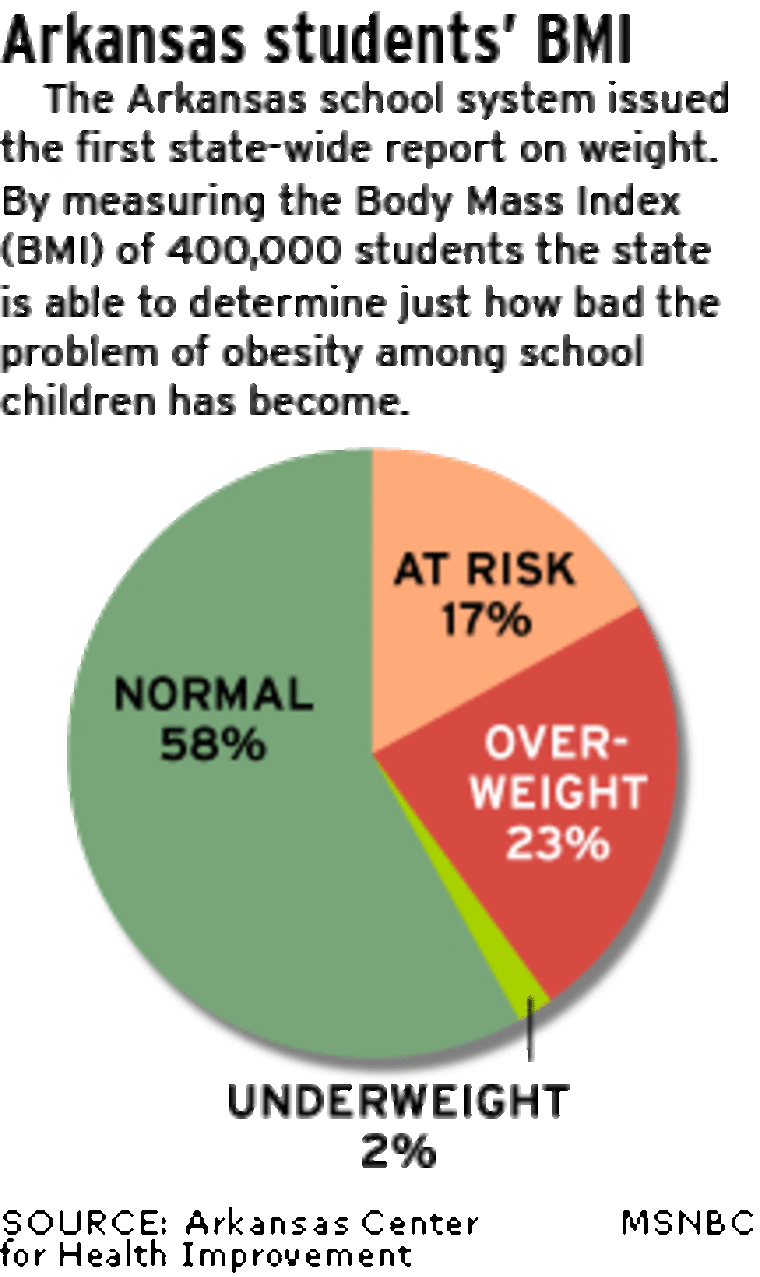Children in Arkansas are getting their report card on weight — and the results aren't pretty. The kids are getting heavier, and at earlier ages, not just in this state, but across the country.
It’s not just a weight issue. It’s also a major health issue — a crisis in the view of experts since overweight children are more likely to develop childhood diabetes, hypertension and lung problems.
In order to tackle the problem, the state of Arkansas has taken a bold step to measure the weight profile of every school child in the state. It’s a report card on weight, although researchers cringe at the term because it implies a passing or failing grade.
Health officials see it as just another screening test — like the vision and hearing tests that school children have received for years. Now Arkansas has added the Body Mass Index, or BMI.
The BMI test came into existence as a result of a cash windfall to the state from a tobacco lawsuit settlement tagged to fund public health programs.
The governor of Arkansas, Republican Mike Huckabee, found himself facing his own health and obesity crisis. He was diagnosed with diabetes and finally found the personal willpower to tackle a diet and exercise program that allowed him to shed more than 100 pounds. Through the experience, he became a national spokesman for combating unhealthy weight.
The stage was set for action. What emerged was a program that drew funding from the Robert Wood Johnson Foundation and, two years later, the first report in the nation on obesity among a state’s entire public-school population.
Determining BMI
Finding a child’s index doesn’t involve calipers to measure fat, but instead takes the weight and height of a child, factors in age and sex, and through a formula calculates the BMI.
With 400,000 students scanned and most of the data tabulated, Arkansas health officials were surprised at just how fat the kids have gotten.
The Centers for Disease Control and Prevention had predicted that 30 percent of young people measured would be at risk or overweight, but the Arkansas numbers came in at 40 percent. The exact breakdown of the Arkansas results were 2 percent “underweight,” 58 percent “normal,” 17 percent “at risk of overweight,” and 23 percent “overweight.”
Dr. Joe Thompson, pediatrician and director of the Arkansas Center for Health Improvement, is leading the BMI program and expected bad news. But even he was surprised “at a 25 percent higher number than any of us had predicted.”
“From our data, two out of five kids who come through the door are at risk or overweight,” says Thompson. The urgent matter now is to “target young people because that’s the place to most likely prevent obesity from starting. The only place to identify and ameliorate, so it doesn’t become a long-term chronic problem for adults," he adds.
Changing diets and lifestyles
But Thompson concedes it’s going to be a tough battle. Pointing to the chart that reflects the growing wave of obesity, Thompson says you can’t blame the problem on genetics. It’s about changing diets and lifestyles.

“Over the last four decades the proportion of overweight kids has increased almost 10-fold and that’s not because of some genetic change," says Thompson. "It’s because our environment has changed, because we have more non-nutritious food available. It’s because our kids aren’t as physically active as three or four decades ago.”
Thompson points to the prevalence of TV watching and video games. “Spend five hours a day sitting and you won’t burn many calories,” he adds. Instead, he urges parents to limit their children's sitting time and push them outside to take part in activities.
The topics of eating habits is also high on his list of behaviors to change for the overweight child. He’d like to see parents offer fewer sodas and provide more low-calorie drinks, such as water and low-fat milk. Thompson also urges families to replace junk food -- what he calls “non-nutritious” items -- with fruits, vegetables and foods low in sugar and salt.
'Clearly a major problem'
The actual BMI report card that is being sent out to Arkansas parents contains such advice. The number itself is given as a range on a bar graph and a pointer tells parents if their child falls into the “normal,” “at risk” or “overweight” range.
Parents whose child falls into the “overweight” or “at risk” range are encouraged to speak with their family doctor about the finding. Health officials are stressing that this is only a screening test, much like a school eye exam, and parents need to follow up on the results with a doctor for further investigation.
Yet, the Arkansas numbers are serious. The “overweight” kids are really overweight, according to the data.
“We’ve under-recognized it," Thompson says. "I think clearly this is a major problem. Our families, our educators and our family doctors have missed what has been a slowly growing problem, until now. It is an epidemic."
An epidemic that health officials say demands action.
Moving forward, the index will be repeated across the state each year. The results will not only tell the story of an epidemic of weight, but will also help Arkansas health officials determine whether they are making any headway in changing the habits and lifestyles that have created the problem in the first place.